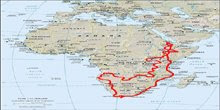We met up with the Amazing Swiss (Marc and Roman) again at Wim’s Holland House in Addis Abeba. We agreed to travel to Nairobi together via the Omo Valley and Lake Turkana, mainly for the security offered by travelling as two vehicles but also because they seemed like pretty cool guys.

Our farewell coffee ceremony at Wim's Holland House
We stocked up with food for the next two weeks, bought some extra jerry cans and then we hit the road south. We stopped at Lake Langano for one night before reaching Arba Minch.
 Our campsite in Arba Minch - a spectacular view when it wasn't raining!
Our campsite in Arba Minch - a spectacular view when it wasn't raining!
We visited the Dorze tribe high up in the mountains above the town. They are most well known for their “elephant houses” constructed entirely of bamboo and false banana tree leaves. The houses are built very tall, but shrink with time because the bases are continuously eaten by termites. After twenty years the house is replaced. We were shown how they spin cotton into thread and use it to weave the traditional scarves and gabis (capes).

Our first elephant house!

Steve trying to weave - man's work

Caro trying to spin cotton - woman's work
We were also shown how to prepare bread from the stems of the false banana stems - traditional fruit bearing banana trees do not grow at this altitude. First the stems are grated to produce a pulp, which is wrapped in banana leaves and buried. It is allowed to ferment underground for three to six months before it is recovered. The pulp, which now has the consistency of bread dough is then flattened, wrapped in banana leaves and cooked on an open fire. Delicious!

The bread making process

Everything made from false banana and bamboo

Marc duelling with a local - his shield made from hippo hide.
 The Amazing Swiss, keen for a chicken potjie at Rocky Hill Campsite, Jinka
The Amazing Swiss, keen for a chicken potjie at Rocky Hill Campsite, Jinka


 Shopaholics
Shopaholics

 Our campsite in Arba Minch - a spectacular view when it wasn't raining!
Our campsite in Arba Minch - a spectacular view when it wasn't raining!









